Вы здесь
Lost World of Kein Keriish.
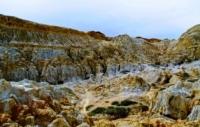
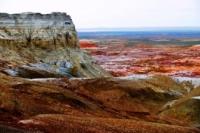
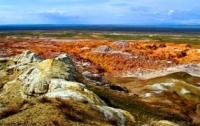
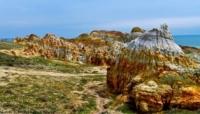
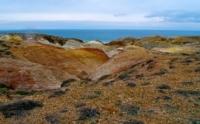
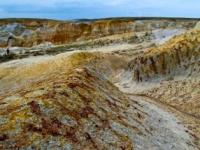
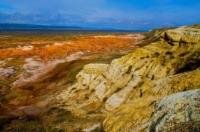
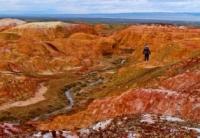
Trip to Keiin Keriish.
“Kirghiz (Kazakhs) call such slides Kerch, and Russians - glinka”
Traveler G.N. Potanin. Journey through the Zaysan depression. 1863.
Holidays on east coast of Lake Zaysan.
Zaysan Basin is a giant lowland among the mountains, in the middle of which lies a large lake. It is called either dry, wormwood steppe, or gravelly-rocky desert. In the north, no matter where you look, the ghostly contours of the distant mountains of Altai are visible, in the east and south the spurs of Tarbagatai - the mountains of Saur and Monrak - are guessed.
The flat plains around the lake alternate with the reddish-gray hills of low mountains. And everywhere under the wheels of car tires is a reddish soil with crunchy multi-colored pebbles. In winter, evil winds rage here, driving snow into the hollows, in the summer there is a drying up heat, and only in the spring the hollow is transformed, covered with a lilac-blue carpet of flowering ixilirions and other early spring flowers. But not only in spring is the nature of the Zaisan Valley happy.
At any time of the year, quiet, affectionate days fall out, and then the surrounding landscapes even in the midst of summer or autumn seem like watercolor paintings painted in Chinese style. Yes, and there is enough exotic. For example, the remnants of multi-colored clay mountains, here and there scattered throughout the basin.
Over the hot steppe, trembling and hesitating, air currents rise. Incorrect, wavy trickles they stretch from the ground and melt in the whitish expanses of the horizon. Far ahead, behind a wall of heated air, ghostly mountains appeared with a light toothed outline. Still distant, they tremble, now disappearing, then reappearing like a fabulous, enchanting mirage.
The closer the fantastic mountains, the more bizarre the outlines of ridges and miniature ridges torn by dried up channels and ravines ravines. The colors of hills and cliffs devoid of vegetation are even more striking.
Pink, purple, lilac, and in some places white, like chalky towers and pyramids, similar to the ruins of a ghostly city, as if hanging over a faded plain. Behind freestanding remnants of white clay extends a multi-colored mountain range with miniature ridges, steep mountain ranges and intermountain valleys.
Even an inexperienced person guesses that unusual clay hills are erosion of bottom sediments of ancient reservoirs. How many centuries of water eroded this hill, composed of silty sediments, with each millennium more deeply biting into the bowels of the earth and exposing more and more new layers of clay! What the water did not do is complement the wind.
Therefore, such remnants are called aeolian. The chaotic mixture of cliffs, crumbling rocks, gorges and ravines, ravines competes here with no less picturesque riot of colors. Yellow, pink, crimson-red chains of mountains with ramparts go to the steppe.
There, crushed into separate pillar-like peaks, the mighty bastions of the “watch towers” rise above, protecting the approaches to the “fortress city”. Their gray walls are dotted with deep potholes, as if after firing cannonballs. Probably, it does not take so much time to smooth out these irregularities on the body of the earth.
It may take several decades, and these extreme, very low turrets will disappear. How many of them have already blurred, leaving behind colorless bald spots that are not overgrown with herbs, huge takyrs, as if! The sun generously floods everything around, reflected in the shiny saucers of takyrs and in the bright sides of the earthen walls. There is nowhere to hide from the hot stream of sunlight at noon, since the tents hardly cast shadows from the sun at its zenith.
On these hills among the boundless steppes you feel yourself trapped on an uninhabited planet. The feeling of abandonment and loneliness does not leave, but it does not depress at all, but rather leads to joyful thrill, fueling the passion of researchers and adventurers.
The Lost World - the memories of Conan Doyle's book read in childhood come to mind. As if confirming these thoughts, piercing clicks of a large bird of prey are heard from above. “Kay ... kay ... kay”! - some kind of voice completely out of tune with the mighty appearance.
This is a Buzzard. On the horizontal ledges under the summit ridge, one after another settled down with half a dozen of its nests. Almost all are old, of past years, and one is residential. Nests are primitive structures made up of coarse fragments of saxaul and branches of juzgun.
Huge, no less than one and a half meters in diameter, in shape they resemble flattened baskets littered with a bunch of junk: faded scraps of newspapers and magazines, rags, various rubbish and even a coil of wire. There, in a nest covered by a ledge of a rock, two bird cubs sat.
Still very small and helpless, they are dressed in downy warm overalls. Just like kids in furry sliders. Flattened in their cradle, they lie with their heads dropped and their noses buried in the side of the nest. Suddenly, under your feet you notice a round, prickly ball on the ground.
Take it in hand, and then comes the hunch that this is a hedgehog. Rather, not a hedgehog, but its dried skin. This is the job of an eagle owl. The animal ate scratched. A flock of swifts interrupts thoughts of the mortality of life. With piercing screams, they circle around, writing out dizzying pirouettes at a terrible speed.
Frightening, they seem to aim right in the face, and, flying very close by, repeat their attacks again and again. Yes, despite the lack of water, life goes on here, among the barren clay hills almost devoid of vegetation. This whole ephemeral aeolian country does not occupy such a large area: some three kilometers in length and no more than one and a half in width.
The mountain massif rises a lonely island in the ocean of a dry, sultry steppe. And around, lost in the distance, for many kilometers a gray plain spreads, shrouded in dusty haze. Only distant cobwebs of roads that cross the valley along and across, and occasionally billowing trickles of dust indicate that you are not on an alien planet.
This is Kiin-Kerish - a natural monument on the northern coast of Zaysan. This is not the only tract on Zaysan rich in eolian remnants. In different places of the hollow bizarre clay mountains rise. The most famous of them are Ashutas east of the lake on the Black Irtysh, Chikilmes (Cape Barkhot) on the north coast, Flaming adyrs south of the lake, in the foothills of the Monrak ridge.
Such aeolian mountains are not only in the Zaysan depression, they are found in Mongolia, and in Western China, and in Central Asia. The ancient Chinese geographers called them Han Hai, suggesting that in their place the vast ancient Han-Hai Sea once existed.
The famous Russian geographer and traveler V. A. Obruchev, having found fossilized remains of fossil land animals in such deposits of Mongolia, was the first to prove the inconsistency of the theory of the existence of the Central Asian Sea.
There was no sea, but there were vast lakes, such as Zaysan and even more. The lakes receded, leaving bottom sediments. They were washed away by spring waters, the winds polished, leaving ravines, among which the outliers rise with tents, spiers, domes.
They are called differently: in Central Asia - chinks, in Kazakhstan - adyrs, kuests and kershs, in Russia - yars. “Kirghiz (i.e., Kazakhs, - the author’s note) call such hills Kerch, and Russian - glinka,” wrote the famous traveler G.N. Potanin, who traveled around Zaysan in 1863. Such mountains were admired and described by travelers Przhevalsky, Singers, Potanin, Kozlov. It is curious that MV Pevtsov, returning from Tibet, showed on the map one of such elevations as a "fort", obviously taking it for an ancient fortress.
In V. A. Obruchev, part of the action of the adventure book "Gold Miners in the Desert" takes place in the same imaginary city. On the southern coast of Zaysan, such red-colored clays located in the Tarbagatai region are locally poetically and very aptly called the Burning Adyrs.
In 1982 they were declared a natural monument. These are steep hills composed of clays of different colors from bright red to brown and green. In 1959, for the first time in Kazakhstan, fossilized remains of a shell of dinosaur eggs were found here.
Paleontological findings are not limited to animal fossils; numerous remains of the ancient flora were immediately discovered: sequoia, bog cypress, plane tree, aralia, gingko, beech, oak, linden. All this made it possible to determine the age and boundary between the Upper Cretaceous deposits of the Mesozoic and Paleogene Cenozoic.
Ashutas Nature Monument is located in the Kurchum region on an area of 150 hectares. Translated from the Kazakh word, Ashutas means a bitter, sour stone. It got its name because of the sulphurous smell of charred plant remains of the ancient flora.
In their list are 79 species of plants, of which 45 are not found anywhere else. The Kiin-Kerish nature monument was created to protect the paleontological objects of the beginning of the Cenozoic and the bizarre relief that the fantasy of nature created.
By the saturation of bone remains and the diversity of species, Kiin Kerish has no analogues in all of Eurasia. Fossils of bones of rhinoceroses, enteledonts, crocodiles, turtles, salamanders, etc. are found here. There are even more representatives of the ancient flora, and they speak of a humid and warm climate in ancient times.
In the recent past, herds of kulans, gazelles, saigas roamed in these deserted places. It is possible that wild horses and camels once lived here, later discovered by Przhevalsky in neighboring Mongolia. Indeed, it was here, in the provincial town of Zaysan, at the end of the century before last that the hunters presented the great traveler with the skin of a hard-maned wild horse.
Later named Przewalski's horse. Now there are no saigas or gazelles in the Priisan steppes, not to mention the kulans. Excessive hunting in the old days devastated once rich lands. By the way, one of the last kulans here, in 1876, was seen and even caught by the expedition of the famous author of "Life of Animals" Alfred Brehm.
But even now rare animals live here: falcon saker, steppe kestrel, demoiselle crane, eagle owl, sajha, black-bellied grouse, ferret dressing, long-eared hedgehog, sandstone hare, bustard, strep. In addition, these hi In the recent past, herds of kulans, gazelles, saigas roamed in these deserted places.
It is possible that wild horses and camels once lived here, later discovered by Przhevalsky in neighboring Mongolia. Indeed, it was here, in the provincial town of Zaysan, at the end of the century before last that the hunters presented the great traveler with the skin of a hard-maned wild horse.
Later named Przewalski's horse. Now there are no saigas or gazelles in the Priisan steppes, not to mention the kulans. Excessive hunting in the old days devastated once rich lands. By the way, one of the last kulans here, in 1876, was seen and even caught by the expedition of the famous author of "Life of Animals" Alfred Brehm.
But even now rare animals live here: falcon saker, steppe kestrel, demoiselle crane, eagle owl, sajha, black-bellied grouse, ferret dressing, long-eared hedgehog, sandstone hare, bustard, strep. In addition, these inhospitable and deserted lands are a haven for rare and endemic mammals and reptiles: dwarf jerboa salpingotus, the size of no more than a walnut, yellow pestle, extinct everywhere, except for the Zaysan depression, Zaysan round-headed, striped snake, eye-eye.
Of course, the areas surrounding the lake deserve to be commanded.
Authority:
Alexander Lukhtanov. "Essays on the nature of the Kazakhstan Altai."
Photos
Alexander Petrov.







